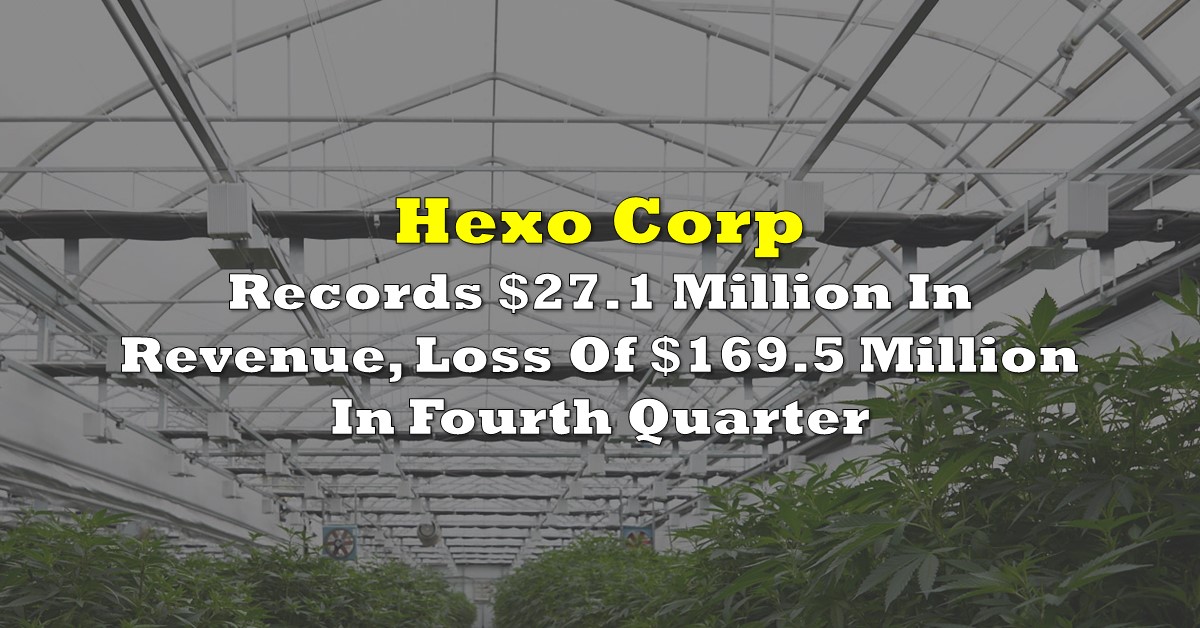Hexo Corp (TSX: HEXO) (NASDAQ: HEXO) reported its fourth quarter earnings this evening, reporting net revenues of $27.1 million for the three month period ended July 31, 2020, along with a net loss of $169.5 million. For the entire fiscal year, the company reported net revenue of $80.8 million and a massive net loss of $546.5 million before tax.

Looking at the fourth quarter, the company posted a gross profit before adjustments of $8.1 million. However it then wrote off $2.2 million in inventory, and marked down the value of current inventory to the tune of $41.9 million, resulting in a gross loss before fair value adjustments of $36.0 million.
Operating expenses for the quarter totaled out to $71.5 million, indicating that Hexo is nowhere near close to profitability. Expenses for the three month period were comprised of a $45.4 million impairment to property, plant and equipment, following by selling, general and administrative expenses of $12.4 million, and share-based compensation of $4.4 million.
During the quarter the company also took a $54.3 million loss on inducement of convertible debentures, a $4.3 million unrealized loss on investments, and an interest expense of $2.7 million among other items. The total non operating loss amounted to a total of $63.3 million during the three month period, contributing to the net loss of $169.5 million over the course of the quarter.
Looking at the full fiscal year at a high level, net revenues of $80.8 million resulted in a gross profit before adjustments of $27.0 million. However, after taking into consideeration $0.7 million in write offs of biological assets, $4.4 million in written off inventory, and a $68.3 million write down on the value of inventory, the actual gross profit for the year amounted to a loss of $46.4 million.
On top of this annual gross loss, the company recorded $418.6 million in operating expenses, including $52.78 million in SG&A expenses, and $26.8 million in share based compensation. On top of this, the year saw a number of impairments such as:
- Impairment of property, plant and equipment of $79.4 million
- Impairment of intangible assets of $108.2 million
- Impairment of goodwill of $111.9 million
- Realization of onerous contract of $4.8 million
- Disposal of long-lived assets of $3.9 million
Total non-operating income for the fiscal year added an additional $76.0 million to the overall loss of $552.5 million for the fiscal year.
Moving to the current balance sheet, the one positive for Hexo is that it currently has a cash balance of $184.2 million, as compared to $94.3 million in the third quarter, a result of having quarterly cash flow from financing activities of roughly $86.6 million. Restricted funds however fell from $17.4 million to $8.3 million over the course of the quarter.
Inventory meanwhile shrank significantly to $64.9 million from that of $105.9 million due in part to write downs. Receivables meanwhile climbed, with trade receivables climbing to $19.4 million and other receivables climbing to $16.7 million, compared to $16.8 million and $12.2 million, respectively, in the prior quarter. Total current assets overall climbed to $305.7 million, up from $259.5 million.
Current liabilities meanwhile climbed significantly, a result of a term loan becoming current during the quarter, resulting in the line item ballooning to $29.9 million, up from $3.1 million. Accounts payable also climbed, hitting $32.5 million as compared to $26.7 million in the prior quarter. Total current liabilities overall climbed from $43.8 million to $82.5 million during the quarter.
Hexo Corp last traded at $0.72 on the NYSE.
Information for this briefing was found via Sedar and Hexo Corp. The author has no securities or affiliations related to this organization. Not a recommendation to buy or sell. Always do additional research and consult a professional before purchasing a security. The author holds no licenses.









